Circular 645
Revised by Naveen Puppala, Natalie P. Goldberg, Leslie Beck, Soumaila Sanogo, Stephen Thomas, and Calvin Trostle
College of Agricultural, Consumer and Environmental Sciences, New Mexico State UniversityAuthor: Respectively, Peanut Breeder, Agricultural Science Center at Clovis, New Mexico State University (NMSU); Extension Plant Pathologist, Department of Extension Plant Sciences, NMSU; Extension Weed Specialist, Department of Extension Plant Sciences, NMSU; Plant Pathologist, Department of Entomology, Plant Pathology and Weed Science, NMSU; Professor, Plant Nematologist, Department of Entomology, Plant Pathology and Weed Science, NMSU; and Extension Agronomist, Texas A&M University AgriLife Extension. (Print Friendly PDF)
Introduction
Peanut (Arachis hypogaea L.) is a high-value legume crop that has been grown successfully in New Mexico and other parts of the United States for many years. Large-scale production of peanut is concentrated in three major geographic areas of the U.S.: the Southeast (Georgia, Florida, Alabama, and Mississippi), Virginia and the Carolinas, and the Southwest (Texas, Oklahoma, and New Mexico). There are four major market types of peanuts: Virginia, runner, Spanish, and Valencia. In the Southeast, runner types are commonly planted, and almost all peanuts planted in Virginia and North and South Carolina are Virginia varieties. Plantings in the Southwest are divided among all four market types, with Virginia and runners comprising the majority of acres.
Most of the Valencia peanuts grown in the U.S. are grown within a 100-mile radius of Portales, NM. Peanut acreage in New Mexico is concentrated in two counties, Roosevelt and Lea. The mild, warm, dry climate and sandy soils in eastern New Mexico make this area very conducive to growing peanuts. Valencia peanuts are popular in the region because they tend to mature faster than other types, have a good and distinctive flavor, and are easily marketed. The value of peanuts harvested in New Mexico exceeds $10 million annually. Maintaining the productivity and sustainability of peanuts in eastern New Mexico is critical to the regional economy. Average yield over the past four years has been 3,500 lb/acre, with typical ranges of 2,500 to over 5,000 lb/acre. Although acres have declined since 2005, New Mexico has produced an average of over 50 million pounds of peanuts annually over the last five years. A considerable amount of peanuts is grown just across the state line in West Texas. Several peanut processing facilities are located in eastern New Mexico, which contributes greatly to the economy and marketability of the crop.
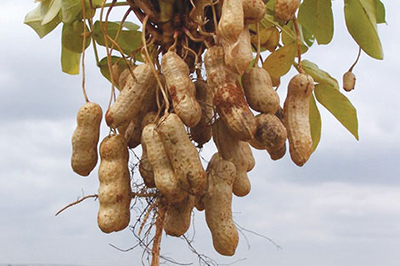
Varieties For New Mexico
While several major market types of peanuts can be grown in New Mexico, Valencia varieties are the most suitable for the climate, soil, length of growing season, yield, and market demand. There are five varieties that dominate the Valencia market type in eastern New Mexico and West Texas: Valencia A, Valencia C, NuMex 01, GENTEX 118, and GENTEX 136. All of these varieties are bunch types with red seed coats. Yield results from five years of research on these commercially available peanut varieties are presented in Table 1.
|
Table 1. Valencia Peanut Yield of Commercially Available Varieties, New Mexico and Texas, 2013–2017 (lb/acre) |
||||||
|
Variety |
Annual New Mexico/West Texas Average |
5-year Avg. 2013–2017 NM and West TX |
||||
|
2013† |
2014 |
2015 |
2016 |
2017 |
||
|
Valencia A |
4153 |
3119 |
3341 |
2145 |
2640 |
3080 |
|
Valencia C |
3854 |
4266 |
3121 |
2640 |
2750 |
3326 |
|
NuMex 01 |
4101 |
3945 |
3328 |
3603 |
3053 |
3606 |
|
GENTEX 118 |
3737 |
3676 |
3997 |
3410 |
2118 |
3388 |
|
GENTEX 136 |
3640 |
3544 |
3795 |
2750 |
2805 |
3307 |
|
Mean |
3897 |
3710 |
3516 |
2910 |
2673 |
3305 |
|
†Average of three sites: Clovis and Portales, NM, and Brownfield, TX. Compiled by N. Puppala, peanut breeder, NMSU Agricultural Science Center at Clovis. |
||||||
Valencia Type Characteristics
1. Valencia A: Released by New Mexico State University (NMSU) Agricultural Experiment Station in 1971. It is a selection made from an older Tennessee Red variety and has a bunch growth habit. It has a 130- to 135-day maturity range. It can be planted slightly earlier than other varieties due to its ability to withstand cooler soil temperatures. Valencia A, the principal Valencia variety produced in the U.S. and grown primarily in New Mexico, is typically marketed as an in-shell edible peanut.
2. Valencia C: Released by NMSU Agricultural Experiment Station in 1979. It was selected for its high percentage of three- and four-seeded pods. It originated from an irradiated population of Colorado Manfredi, a pure line selection from Colorado de Córdoba seed introduced from Argentina. It matures three to five days earlier than Valencia A. Valencia C typically has a higher percentage of sound, mature kernels than Valencia A. Valencia C has been shown to outyield Valencia A by 300 to 400 lb/acre.
3. NuMex 01: Released by NMSU Agricultural Experiment Station in 2013. NuMex 01 originated from a cross made between New Mexico Valencia A (NM Valencia A) and Brantley. Pedigree selection was practiced based on oil quality as determined by high oleic (O):linoleic (L) fatty acid ratio, pod size and shape, seeds per pod, seed size, testa color, market type (Valencia), maturity, yield, and grade characteristics. Seed is contracted with Hampton Farms in Portales, NM. It matures similarly to Valencia A, but yields typically 400 lb/acre higher than Valencia A. NuMex 01 is the first high-oleic (O:L ratio of 23.3 compared with 1.1 in NM Valencia A) Valencia peanut cultivar released for cultivation in eastern New Mexico and West Texas. NuMex 01 has good roasted flavor attributes.
4. GENTEX 118: Released by a private company in 2012. Seed is contracted with Borden Peanut company in Portales, NM. It is normally the same as Valencia A. Yields have been similar to Valencia C and typically 300 to 350 lb/acre higher than Valencia A. Matures almost similarly to Valencia A, Valencia C, and GENTEX 136.
5. GENTEX 136: Released by a private company in 2001. Seed is contracted with Sunland, Inc. in Portales, NM. This variety is highly preferred for boiling purposes due to its sweet taste and larger seed size and is exported to eastern parts of the U.S. It is contracted up to $0.10 per pound higher than other varieties. Yields are comparable to Valencia C, but are typically 200 to 250 lb/acre higher than GENTEX 101 and GENTEX 102. Care must be taken to harvest this variety on time because overmaturity can result in digging and combine losses.
Other peanut varieties, including runner and Spanish types, are available to New Mexico producers, and they may perform quite well given proper moisture, fertilizers, and growing conditions. For information on runner and Spanish production relevant to New Mexico, view or download the Texas Peanut Production Guide at https://peanut.tamu.edu.
Land Selection, Crop Rotation, and Soil Preparation
Land Selection
Soils best suited to peanut production are well-drained, light-colored, loose, friable sandy loams with topsoil depths of 1.5 to 2.0 feet that contain high levels of calcium and a moderate amount of organic matter. These soils allow for easy penetration of roots and pegs, fewer disease problems, and easier harvesting. Better yields may be obtained with heavier-textured (clay) soils, but these soils tend to adhere to the pods, causing discoloration (staining) that reduces market quality and value; clean, properly colored shells are particularly important with Valencia peanuts. These heavier soils often increase percentages of foreign material at harvest. Peanut plantings should be avoided in fields with shallow topsoil (e.g., caliche soils) or high salinity, or in poorly drained areas. The availability of adequate irrigation water, free of significant salinity levels, is key for optimal Valencia yields (see Irrigation and Water Use section).
Crop Rotation
Peanuts are extremely sensitive to the effects of other crops grown in rotation with them, especially those that immediately precede them. They respond better to good rotations than many other crops. Rotations that consist of three years out of peanuts or other legumes are recommended to promote high yields and avoid problematic pests. Further, Valencia peanuts are more susceptible to pod rot and should be rotated with a minimum three-year interval between peanut crops. A four-year rotation out of Valencia peanuts is recommended by New Mexico and Texas Cooperative Extension Services. Limited land availability may cause growers to try to grow peanuts on the same land for two years or every other year; this is highly discouraged because it could lead to significant disease issues and is simply not worth the risk.
Peanut seedling diseases may be more pronounced and damaging when peanuts follow peanuts or cotton. Leaf spot and web blotch diseases are usually more severe when peanuts follow peanuts; however, research in Georgia has shown that leaf spot can be reduced if peanuts follow corn or cotton. Verticillium and Fusarium wilts can increase when peanuts follow potatoes and other vegetable crops (see Disease and Other Pests and Their Control section).
Grass-type crops, such as corn, sorghum, millet, or other small grains, are the best choice to immediately precede peanuts. These rotation crops are advantageous from a marketability standpoint because the large number of dairy cattle in New Mexico provides a consistent demand for and ample opportunity to sell forage products. Fertilization requirements of these grass crops can contribute to residual soil fertility for the following peanut crop. The deeper root systems of peanuts can use soil nutrients that may have leached below the shallow rooting zones of many row-crop grasses. Rotating peanuts with grass-type crops reduces the incidence of blackhull, leaf spot pathogens, Verticillium wilt, stem rot, and northern root-knot nematodes. Grass crops do not serve as hosts for these diseases and can reduce the quantity of potentially infective disease inocula for subsequent peanut crops.
Any rotation program will have some problems associated with it. Without the addition of organic materials such as manure or compost, freshly broken-out pasture land on regional sandy soils typically has an organic content that is too low for good peanut production. In addition, land previously in corn or grain sorghum may have herbicide residues (e.g., s-triazine types) that could carry over and damage a following peanut crop. Slow decomposition of large-stalked corn residues can encourage peanut pod rot and pod discoloration.
Soil Preparation
As with any crop, a clean, firm seedbed is essential for good stand establishment and plant health. Soil preparation is very important in reducing the potential for peanut diseases. Allow time between decomposition of the previous crop residue and growth of a subsequent peanut crop to reduce the number of soil fungi involved with the decomposition process. Approximately three months before planting, fields should be plowed as deep as necessary to turn under all surface residues and to eliminate existing weeds. Adequate soil moisture and nutrients should be available to enhance decomposition of crop residues. It may be necessary, in the case of large-stalked residues, to add nitrogen to assist in the growth of soil microbes that are responsible for residue decomposition. Nitrogen not used by the decomposition process normally will be available for the peanut crop.
Reduced tillage operations (e.g., strip-till) can be successful in certain situations. Potential benefits include seedling protection from blowing sand, higher water retention, and, in some cases, fewer diseases. In reduced tillage systems, however, weed control may be more difficult, and pre-plant herbicides will have to be incorporated with irrigation. In addition, harvesting efficiency may be hindered by excessive foreign matter mixed with dug peanuts in high residue conditions. Results are mixed on any yield advantage of peanuts in strip-till in other parts of the country. Row spacing at 30 or 38 inches produces more disease-free crops, requiring less fungicide and providing higher economic yields than other spacings. While narrower row spacings allow for more rapid ground cover, they may lead to a greater incidence of disease.
Soil Fertility
Fertilizer requirements for each field should be determined by laboratory soil analyses, and it is important to follow fertilizer recommendations for each field and yield goal. A balanced fertility program, with emphasis on available levels of phosphorous, calcium, potassium, magnesium, and nitrogen, is essential for high yields. Late January or early February is the optimal time for performing necessary analyses, which can be justified in New Mexico Valencia peanuts more than many other row crops due to their high per-acre value. In general, peanuts respond best to residual fertility left over from previous crops. For more information on soil testing, see NMSU Extension Circular 676, Interpreting Soil Tests (https://pubs.nmsu.edu/_circulars/CR676.pdf).
Peanuts, like all other legumes, have a symbiotic relationship with Bradyrhizobium bacteria that fix atmospheric nitrogen and provide it to the plant. A good plant-bacteria association is characterized by numerous nodules on the roots (Figure 1).
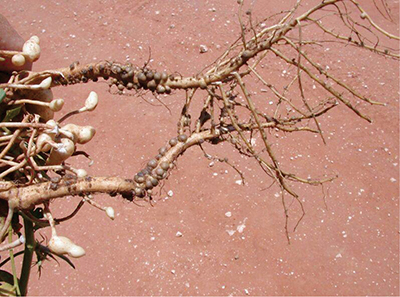
Although peanuts can provide some to most of their own nitrogen through this relationship, young seedling plants require soil-available nitrogen. Healthy, vigorous seedlings can be ensured with 10 to 20 lb/acre of starter nitrogen. If soil tests indicate this much nitrogen is available as carry-over from the previous crop, additional nitrogen may not be necessary. Many producers in eastern New Mexico apply up to 100 lb/acre of nitrogen fertilizer to ensure adequate nitrogen throughout the growing season.
Although applied nitrogen may boost yields, too much early on (i.e., pre-plant) can lead to poor nodulation and limited nitrogen fixed by the plant later in the growing season. Nodulation should not be adversely affected by nitrogen applications of 30 lb/acre or less. With high fertilizer costs, it is better to ensure good nodulation early than to try and supply the plant’s nitrogen needs with fertilizers throughout the growing season. Nodulation should be assessed prior to large nitrogen fertilizer applications. Total mid-season nitrogen applications may be cut nearly in half if nodulation of plants is high (Table 2).
If, on the other hand, nodulation is poor or non-existent, additional nitrogen will be necessary for high yields. In addition, excessive nitrogen may increase weed pressure and disease problems by causing more extensive vine production, which results in canopy closure earlier in the growing season.
Calcium is very important for nodulation and proper pod development and quality. Soils of the eastern peanut-growing region of New Mexico typically have adequate available calcium in the pegging zone for Valencia varieties. Heavy rates of potassium-containing fertilizers applied to the pegging zone can interfere with calcium uptake for developing pegs and pods. The most critical time for an adequate calcium supply (soil test of 600 ppm or greater in the pod zone) is three to four weeks after the initiation of pegging, when calcium uptake by the plant is greatest. Calcium uptake occurs directly into the pod from the surrounding moist soil, and water-stress conditions limit uptake and tend to exacerbate any deficiency symptoms.
Certain micronutrients, including boron, zinc, iron, manganese, copper, and molybdenum, are also essential to peanut production. Boron deficiency is one of the micronutrient deficiencies that may occur on sandy soils in peanuts. Low boron can lead to split stems and roots, impair normal seed development, and cause hollow heart. Hollow heart is an irregularly shaped, blackened cavity on the inner face of the peanut seed; the condition is classified as concealed damage. Evidence from field studies indicates that symptoms of boron deficiency are more likely to occur at high yield levels. Soils testing at less than 1 lb boron/acre should be considered for boron application, especially if there is little to no boron in the irrigation water used. Some irrigation water in the region can have enough boron to supply a peanut crop with several pounds in one year. Only apply boron when there is a deficiency because too much boron can lead to toxicities and may reduce yield and quality.
Zinc-deficient soils can also reduce crop yields. Soils are deficient if the DPTA extractable zinc concentration is less than 0.4 ppm. Zinc deficiencies can occur in alkaline soils that are low in organic matter and high in available phosphorous. In addition to applying zinc fertilizers, adding large amounts of organic materials, such as manure, and incorporating plant residues are also helpful. The most common recommendation for inorganic zinc fertilizer application is 6 to 10 lb/acre. Zinc remains available in the soil for several years, although it may be tied up with phosphorus; soils should be tested before adding zinc. Symptoms of zinc deficiency can occur concurrently with symptoms of iron deficiency. The chlorotic strips of zinc deficiency are usually wider than those of iron deficiency on the portion nearest the petiole and may not run the entire length of the leaflets. High temperatures can cause zinc deficiency to appear as leaflet bronzing. Zinc-deficient plants may also be stunted.
Soils in eastern New Mexico’s peanut-producing region are generally alkaline. Alkaline soils may also be deficient in copper, manganese, and available iron. Nutrient deficiencies, with the exception of iron, can be corrected by applying the required nutrients before or at planting. Iron deficiency can occur in soils with pH over 7 and may be corrected with foliar applications of iron chelates or iron sulfates; however, results are often inconsistent with respect to actual effectiveness. Applying iron through irrigation systems is not an efficient mode of application since it dilutes the product and very little iron stays in contact with the leaves. Soil applications may cause the iron to be chemically bound and unavailable. Late-season foliar applications of any of the micronutrients rarely result in economic returns.
Inoculants
Peanuts should be evaluated early in the growing season to determine the degree of nodulation of Bradyrhizobium on the roots (Table 2). Early diagnosis will not only help with determining mid-season nitrogen needs but will also let the grower know if inoculants are needed for subsequent peanut crops in fields that contain low levels of Bradyrhizobium. Peanut-specific inoculants are commercially available to help improve nitrogen uptake by the peanut plant when new fields are brought into production.
|
Table 2. Bradyrhizobium Nodulation Guidelines for Sampling Peanut Root Nodulation at Five to Six Weeks After Germination |
||
|
Status |
No. of nodules per plant |
Mid-season N adjustment |
|
Poor |
0–5 |
No adjustment |
|
Fair |
6–10 |
No adjustment with high yield goal |
|
Good |
11–15 |
Decrease slightly |
|
Very good |
16–20 |
Decrease up to 1/2 total N |
|
Excellent |
21+ |
Decrease up to 1/2 total N |
|
Adapted from Trostle (2005). |
||
Research in West Texas has shown varying results and benefits of different types of inoculants. Liquid, in-furrow inoculant applications seem to work best and have the potential to provide the highest nodulation and yield response, while powder seedbox inoculants have little or no effect on nodulation. All Bradyrhizobium inoculants nodulate less when peanuts are planted into dry soil or with seed placement less than 1.5 inches deep. Granular products have shown intermediate performance, but are still a good choice and may not dry out as fast as liquid in dry conditions. Inoculants of any kind have seldom been shown to increase crop yields in New Mexico, especially if nodulation is already adequate or if products are placed shallow in hot, dry soils.
Experience suggests that benefits associated with soil inoculants are significantly improved if seeds are planted slightly deeper (into moisture) and if soils are kept moist through rain or irrigation, especially during early growth stages. In general, Valencia peanuts nodulate less than other peanut types because of smoother taproots and fewer infection sites for the bacteria. Nevertheless, Extension recommends that producers include inoculants in their programs and that they ensure that application equipment is working properly, calibrated, and delivering the inoculum directly to the seed furrow as close to the seed as possible.
Seeding
Valencia peanut seed is the most vigorous among the different market types, but, like all peanut seed, Valencias are fragile and should be handled and planted with care. Split seeds will not germinate. Valencia varieties typically range from 900 to 1,200 seeds per pound, and planting rates are generally from 75 to 100 lb/acre, or about 75,000 to 100,000 seeds per acre. Because seed size may vary up to 20% for variety and seed lot, it is better to use number of seeds per acre for planting rates. If planting on 30-inch rows, there are 17,424 row-feet per acre (e.g., six seeds per foot equals about 104,500 seeds per acre, or 95 lb/acre if seed is 1,100 seeds per pound).
Extension and buying point staff typically suggest that a seeding rate of six seeds per foot of row is adequate for peanuts, but producers often plant slightly more to ensure a thick stand. Lower seeding rates are more commonly used on single-row beds, while the higher rates are used on double-row (twin-row) plantings. Plant populations after establishment vary from 60,000 to 80,000 plants per acre for 30-inch row spacings (about 3.5 to 4.5 plants per foot of row). When considering the high cost of seed, there usually is no economical increase in productivity with increased seeding rates at typical row spacings. As row spacing narrows, seeding rates may be adjusted upward. Narrow row spacings have the advantages of rapid canopy closure (good for weed control), cooler soil temperatures for pegging, and less water evaporated from the soil surface. However, equipment size restrictions may limit the degree to which rows can be narrowed.
Seeding depth should be between 1.5 and 2.0 inches. If topsoil is moist, seeds placed at shallower depths usually germinate quickly; however, peanut seed is large and must absorb more moisture than most other crops in order to germinate. Hence, ensuring adequate moisture for several days is critical. During dry conditions or drought years, seeds may have to be planted deeper into available moisture for germination, especially if inoculants are used. Seed planted into loose, fluffy soil may settle too deep if heavy rains follow planting. The shorter the time period between planting and actual seed germination, the less susceptible seedlings will be to soil-borne disease and insect problems. Time to emergence will depend on planting depth, seed quality, soil temperature, and available moisture. In all areas of New Mexico, planting should be delayed until the soil at seed depth has warmed sufficiently for rapid germination and seedling emergence. Optimal planting date is generally determined by soil temperatures above 60°F for five or more consecutive days. Peanut seeds have a minimum soil temperature requirement for germination that varies with variety. Peanuts should be planted in warm, moist soils. Planting peanuts in cool, wet soils or planting seed too deeply or too early may result in slow seed germination and seedling emergence. These factors contribute to seedling diseases and poor stands and may influence replanting requirements.
The number of days between the optimal temperature for germination and the first killing frost should be considered when selecting the peanut variety. Valencia varieties average about 125 to 135 days to reach maturity, Spanish require 140 days or more, and Virginia and runner market types typically need at least 160 days.
Irrigation and Water Use
Irrigation of peanuts is necessary in eastern New Mexico and West Texas in order to obtain consistent and high yields and to prevent aflatoxin incidence. Not only is irrigation required for yield consistency, it is one way to incorporate common herbicides used in peanuts (e.g., Prowl, Sonalan, and Treflan). Water requirements of peanuts vary during the season. Daily water use is typically low early in the season; peaks during mid-season at flowering, pegging, and pod formation; and decreases again near crop maturity.
A peanut crop’s water demand depends on the growth stage of individual plants. During seedling development, root growth can reach a 1-foot depth in 11 days. By this time, taproots and lateral roots are well developed, but only four leaves will have developed on the plant’s main stem. Hence, water use is low during this time. Early water logging can lead to poor nodulation and resultant low nitrogen fixation by bacteria later in the season.
During vegetative growth, flowering, pegging, and pod development, water demand rises sharply and water availability is critical. Research has shown that moisture stress during this period has the greatest effect on reducing yields. Adequate water is also required to provide movement of calcium into the developing pods from the soil solution, and, as mentioned previously, calcium uptake is restricted by water stress. Extremely high soil temperatures and dry conditions can inhibit peg penetration; therefore, it is important to keep the soil as cool and moist as possible during this critical time. However, too much rainfall or irrigation can promote vegetative growth at the expense of reproductive growth. By contrast, the ratio of pods to vegetation is not increased by prolonged drought. High humidity during flowering is advantageous in that it allows for good, uniform flower development and pollination, thereby leading to earlier maturity and harvest.
Peak daily water use varies from 0.20 to 0.30 inch per day (or about 1.5 to 2.0 inches/week from July through August), with an average of about 0.25 inch per day. On extremely hot, dry days, water use can increase to 0.40 inch per day. On such days, even plants growing in a soil profile full of water may wilt during the afternoon. The plant’s protective mechanism causes the peanut plant to conserve moisture. This is temporary wilt that should disappear during the night, and there is little yield reduction with temporary wilt.
Crop water demand declines during pod fill through maturity, and irrigation can be scaled back somewhat during this time. Too much water, especially in late season and during pod maturation, promotes soil-borne diseases, leaches certain nutrients required for proper pod development and production, and can cause some maturing kernels to germinate, reducing the percentage of sound mature kernels at harvest. Moderate amounts of moisture at this time should be kept as consistent as possible since repetitive wetting and drying can cause pod hulls to split and may lead to higher levels of aflatoxin, which tend to accumulate under dry conditions prior to harvest.
Peanuts use between 20 and 30 inches of water during the growing season. Average rainfall during the growing season (April 1 to October 1 in Roosevelt County) is about 12 inches, leaving a deficit of 8 to 18 inches that must be provided by irrigation. All peanut irrigation systems should be able to meet the water needs of the crop over the entire field and should be able to apply water at a rate that does not exceed the soil’s infiltration capacity. Uniform water distribution is necessary because the soils in which peanuts are grown have a relatively low water-holding capacity. Irrigation should fill the water-holding capacity of the soils, even in sandy and sandy loam soils. It is recommended to have a full soil profile prior to planting so that plants will have deep reserves to draw from in the case of extreme conditions, that is, if system capacity cannot keep up with plant demand or the irrigation system breaks down. Irrigation system capacity should be matched closely with the total projected water demand of the crop. It is better to grow fewer acres of peanuts than to have more acres than the system can adequately supply. Regional observations indicate that a minimum of 600 gallons per minute (GPM) are required for a full 120-acre (i.e., 5 GPM/acre) circle of peanuts. If available irrigation tails off late in the season, this should be factored into decisions about producing peanuts.
Water quality is another important factor to consider when planning to grow peanuts. As area irrigation well capacities continue to decline, more growers will be looking to use alternative sources (i.e., lower-quality water) of irrigation for crop production. In these situations, it is imperative that producers obtain water quality analyses prior to growing any crop. Peanuts are more sensitive to salts than many other crops grown in the region. Irrigation water critical levels are established for peanuts for total dissolved solids (TDS; or electrical conductivity, EC) as well as several constituents, such as boron, chloride, and sodium. These critical levels represent the point beyond which a decline in yield potential is expected. In general, research has shown that water testing at 1,344 ppm of TDS (EC = 2.1 mmhos/cm or greater; McFarland et al., 2002) or water having a sodium absorption ratio (SAR) greater than 5 should be considered suspect and may lead to yield and/or pod quality reductions. In addition to TDS in irrigation water, individual constituents in the water could pose a potential problem to peanut production (Table 3).
| Table 3. Critical Values for Salts and Other Constituents in Irrigation Water for Peanuts (McFarland et al., 2002) | |
|
Constituent |
Critical value |
|
Total dissolved solids (TDS) |
1,344 ppm |
|
Electrical conductivity (EC) |
2.1 mmhos/cm |
|
Boron (B) |
0.75 ppm |
|
Chloride (Cl) |
400–500 ppm |
|
Sodium (Na) |
400–500 ppm |
High salts can cause leaf burn, inhibit water uptake, and interfere with uptake of certain essential elements (e.g., calcium). Management of these systems may prove difficult because leaching of salts from the root zone will require large amounts of water, and continuous additions of salts potentially lead to toxicity issues and overall soil degradation. Frequent, low-quantity applications of saline water tend to increase salts in the soil more than less-frequent, high-quantity waterings.
Harvest
Proper harvest timing is critical for optimizing both yield and quality of peanuts. Significant reductions in yield can occur if harvest is delayed too long. It is better to harvest a little on the early side than to wait too long for a small proportion of immature pods to develop. However, harvesting too early can result in immature peanuts, low yields, and off flavor. Fields should be scouted late in the growing season and inspected often for pod maturity. At optimal harvest time, a particular peanut plant will have varying degrees of mature and immature pods.
With Valencia peanuts, it is best to harvest when 75% or more of the pods on the plants are mature. Several areas of a field should be inspected to get a good estimate of total field maturity. Pods will darken and turn brown to black on the inside of the shell and just below the outer layer of the outside of the pod when mature. The “hull-scrape method” can be used to determine the extent of pod maturity by using a pocket knife to scrape the outer layer of the pod to expose the cellular layer below. If there are questions about the timing of digging Valencia peanuts, producers should speak with their contractor. In general, these contractors want to ensure that few highly desired pods are left in the field, even if it means digging as early as 50 to 60% maturity. If 75% or more of the pods on a plant are mature in several portions of the field, digging should commence immediately.
While assessing maturity, growers should also be sure to observe the crop for any signs of pod detachment. For example, if one foot of row is removed from moist soil at several points around the field, and if as little as one large pod remains in the soil for just half of the sites, then the producer should consider digging very soon. As much as 500 lb/acre yield loss can occur with a seven-day harvest delay beyond this point. Having too many acres that mature at the same time may cause some fields to be harvested too late due to time, labor, and equipment constraints.
Digging should be deep enough to prevent cutting of pegs and to minimize the loss of mature, high-grading pods. If vines are particularly dry, extensive pod loss may occur. Peanuts grown on beds have the potential to fall down into the furrow at digging, which leads to slower drying, more difficult combine pickup, and more foreign material. Rapid drying and threshing are important to maintain yield and grade. Peanuts should be dried to near 10% moisture prior to threshing. Threshing at moisture levels below 8% could cause high levels of loose-shelled kernels.
Weeds and their Control
Peanut producers in eastern New Mexico must contend with a diverse collection of weeds ranging from annuals to perennials, and from grasses to broadleaves and sedges. Weeds compete with peanut plants for available resources, including water, nutrients, and light. This competition is especially impactful in the early stages of peanut growth when competition between the crop and the weeds is at its greatest (early season). While competition with resources poses less of a threat to mature peanut plants, late-season weeds could cause harvest problems and may produce seeds that will germinate in following years. Therefore, weeds can affect peanut yield and quality and need to be controlled effectively. Successful peanut weed control requires proper management practices throughout the growing season, which include cultural, mechanical, and chemical methods. However, developing an effective management program requires proper weed identification since some practices (e.g., herbicides) are species-specific.
Cultural and Mechanical Practices
Cultural weed control practices mainly include appropriate crop rotation, crop management, and using cover crops. Crop rotation is essential in weed control programs because certain weeds that are not easily controlled in peanuts may be easily controlled by common weed management practices (e.g., herbicides) in other crops. Any crop production management factors that could positively influence the performance of peanuts in the field (soil fertility, variety and seed selection, disease and insect management, timely planting and harvest) could affect the weed management outcome. A vigorous, healthy, and dense stand of peanut will effectively outcompete germinating weeds, especially later in the growing season. Cover crops that can be planted in close proximity (e.g., wheat, pearl millet, or mustards) will reduce weed pressure by limiting light penetration on the soil surface, thereby reducing weed germination and growth. Cultivation may also be utilized to complement other methods of weed control, especially in the early season. However, improper use of cultivation (e.g., bad timing and improper depth) could disturb the development of pegs and increase disease problems. Weed management success is always enhanced when multiple management practices are combined to create an environment that is least ideal for weed germination and establishment.
Chemical Practices
Herbicides are effective components of weed management strategies in peanuts. However, their efficacy can be increased if they are used along with other cultural and mechanical practices as part of an integrated weed management plan. There are three basic classes of herbicides for weed control in peanuts: pre-plant incorporated, pre-emergence, and post-emergence. Pre-plant incorporated herbicides are applied and incorporated into the soil prior to planting. Pre-emergence herbicides are applied on the soil after planting but prior to weed and crop emergence. Post-emergence herbicides are applied after weed emergence, and their effectiveness is critically dependent on their timing of application. Some post-emergence herbicides are applied on emerged weeds prior to planting or emergence of peanuts (burndown treatments).
Many factors, including equipment calibration, timing of application, rate of application, soil type, temperature, wind speed, soil moisture, weed lifecycle, and weed stage of development, can significantly influence the efficacy of herbicides. Therefore, selecting the right herbicides based on the target weed species and following the label instructions and precautions for herbicide use are critical for preventing peanut injury and off-target injury and achieving acceptable weed control. The use of dinitroaniline, or “yellow” pre-emergence herbicides (e.g., Prowl H2O, Treflan, Sonalan), can be effective at controlling weeds as they germinate from seed. These herbicides will have little effect on weeds that have already emerged, and thus timing applications of pre-emergence herbicides just prior to the onset of conditions that are favorable to weed seed germination is critical for success. As a result, the use of these herbicides can provide a good foundation for seasonal weed control, and good incorporation (i.e., tillage or irrigation) into the soil is also critical to their success. Post-emergence herbicides have the greatest impact early in the growing season when weeds are small and when weed competition with peanut growth is greatest. One drawback of consistent use of herbicides to manage weeds is the ever-evolving development of herbicide resistance (“super weeds”). The best way to prevent further developments of resistance is to alternate a different herbicide mode-of-action from one application to the next. For more information, see NMSU Extension Guide A-616, Herbicide Resistance: Development and Management (https://pubs.nmsu.edu/_a/A616.pdf).
Table 4 lists herbicides that are registered for use on peanuts in New Mexico along with their suggested label rates, application timings, and some examples of susceptible weeds. Selecting the proper herbicide requires correct identification of the weed species in the field. Correct weed identification is critical prior to the selection and application of all herbicides for successful weed control.
|
Table 4. Herbicides1 Labeled for Use on Peanuts in New Mexico as of 2017 |
|||
|
Herbicide* (example of trade name) |
Rate2 |
Application timing3 |
Example of weeds controlled4 |
|
2,4-DB* (2,4-DB 200) |
0.8–1.6 pints/acre |
Post-emergence |
Broadleaves: morningglories, cocklebur. |
|
Alachlor* (INTRRO) |
1.0–3.0 qts/acre |
Pre-plant, pre-emergence |
Broadleaves and grasses. Incorporation must be ABOVE seed. Rates dependent on soil type. |
|
Bentazon (Basagran) |
1.0–2.0 pints/acre |
Post-emergence |
Broadleaves: morningglories, ragweed. Sedges: yellow nutsedge. |
|
Bentazon and acifluorfen (Storm) |
1.0–1.5 pints/acre |
Post-emergence (pre-emergence at soil cracking stage) |
Broadleaves: morningglories, ragweed, pigweed, spurred anoda, cocklebur. Sedges: yellow nutsedge. |
|
Clethodim |
6.0–16.0 fl oz/acre |
Post-emergence |
Annual and some perennial grasses. |
|
Carfentrazone-ethyl (Aim EC) |
1.0–2.0 fl oz/acre |
Post-emergence |
Broadleaves: kochia, pigweed, morningglories. |
|
Dimethenamid (Outlook) |
10.0–21.0 fl oz/acre |
Pre-plant incorporated, |
Annual grasses: foxtails, johnsongrass (seedling), crabgrass. Broadleaves: pigweeds, ragweed. Sedges: yellow nutsedge. |
|
Ethalfluralin |
1.5–3.0 pints/acre |
Pre-plant incorporated |
Broadleaves: kochia, pigweed, Russian thistle. Grasses: foxtail, junglerice, sandbur. |
|
Flumioxazin |
2.0–3.0 oz/acre |
Pre-plant incorporated, |
Broadleaves: kochia, pigweed, mustards, Russian thistle. Grasses: barnyardgrass, crabgrass, foxtail. |
|
Glyphosate (RoundupPowerMAX) |
0.34–3.3 qts/acre |
Pre-emergence to crop (burndown) and spot treatment |
Emerged annual and perennial broadleaf weeds |
|
Imazapic (Cadre) |
4.0 fl oz/acre |
Post-emergence |
Broadleaves: spurred anoda, pigweed, morningglories. Grasses and sedges: johnsongrass, yellow nutsedge. |
|
Imazethapyr (Pursuit) |
4.0 fl oz/acre |
Pre-plant incorporated, |
Wide range of broadleaf weeds. Grasses and sedges: johnsongrass, yellow nutsedge. |
|
Lactofen (Cobra) |
12.5–25.0 fl oz/acre |
Post-emergence |
Broadleaves: pigweeds, morningglories, ragweed, kochia. |
|
Norflurazon |
0.5–2.5 lb/acre |
Pre-emergence incorporated |
Broadleaves: pigweeds, morningglories, ragweed, mustards, kochia. Grasses: crabgrass, cheatgrass, foxtail. |
|
Oxyfluorfen (GoalTender) |
0.5–1.0 pints/acre |
Pre- and post-emergence |
Pre- and/or post-emergence activity for control of winter annual weeds. Apply at least 60 days prior to planting peanuts (fallow bed treatment). |
|
Paraquat dichloride* (Gramoxone Inteon) |
8.0–16.0 pints/acre |
Post-emergence |
Contact herbicide used to control or suppress a broad spectrum of emerged weeds. |
|
Pelargonic acid (Scythe) |
Application-dependent rates 3–10% v/v |
Post-emergence (burndown) |
Burndown of annual and perennial broadleaves |
|
Pendimethalin |
0.5–4.0 pints/acre |
Pre-plant incorporated |
Broadleaves: kochia, pigweed. Grasses. |
|
S-metolachlor |
0.8–1.33 pints/acre |
Pre-plant incorporated, |
Broadleaves: pigweed. Grasses and sedges: foxtail, barnyardgrass, crabgrass, yellow nutsedge. |
|
Sethoxydim |
1.5–3.75 pints/acre |
Post-emergence |
Annual and perennial grasses. |
|
Trifluralin |
1.0–1.5 pints/acre |
Pre-plant incorporated, |
Broadleaves: kochia, pigweed, Russian thistle. Grasses: barnyardgrass, crabgrass, cheatgrass, foxtail. |
|
1 The recommendations in this publication are provided only as a guide. The authors and New Mexico State University assume no liability resulting from the use of these products. Please be aware that pesticide labels and registration can change at any time; by law, it is the applicator’s responsibility to use pesticides ONLY according to the directions on the current label. Use pesticides selectively and carefully and follow recommended procedures for the safe storage and disposal of surplus pesticides and containers. * Restricted-use herbicide in New Mexico. 2 Refer to label directions on appropriate application rates to control specific weeds in peanut planted in certain soil types. 3 See Chemical Practices section regarding application methods. Refer to label for specific application method descriptions. 4 Consult herbicide labels for the list of weeds controlled and weed size limitations. Most chemical labels can be accessed at either https://www.greenbook.net or https://www.cdms.net/. For more information on weeds in New Mexico, visit https://weeds.nmsu.edu/. |
|||
Disease and Other Pests and Their Control
Peanut is susceptible to a number of stem, foliage, pod, and root diseases. It is important to recognize potential disease problems in order to effectively use management strategies. Each producer must develop a disease management plan—preferably for each field—from crop records of past disease problems. Records should be kept for all crops grown in the field since diseases are seldom unique to a specific crop. Knowledge of previous crops and diseases in a field can alert a producer to potential problems.
Peanut diseases can greatly reduce both quality and yield. Most of these diseases can be reduced by using good sanitation and cultural practices that lead to vigorous plant growth. The following are some general recommendations for managing peanut diseases.
- Employ good crop rotation practices. Grass-type crops preceding peanuts help to reduce some diseases. Cotton, potatoes, chile, and other vegetable crops are problematic when planted prior to peanuts because many of the same disease pathogens attack both crops. Likewise, peanuts following peanuts, particularly for more than two consecutive years, should be avoided.
- Shortly after harvest, turn under as much of the crop residue as practical.
- At the end of the growing season for the previous crop, test the soil for nematodes and treat with a nematicide if a problem exists.
- Before planting, obtain a soil analysis and fertilize accordingly.
- Prepare a seedbed free of crop residue and large clods.
- Avoid early plantings in cold soils.
- When possible, use resistant cultivars.
- Use high-quality seed with a high germination percentage and treat seed with a recommended fungicide (note: special considerations for organic).
- Plant seed at a uniform depth and avoid deep seed placement.
- Irrigate when necessary to ensure the deep roots of the plant are exposed to adequate water.
- Flat cultivate so soil and trash are not pulled toward the plants.
- Harvest should be timed to achieve at least 70% sound mature kernel score. Overmaturation can result in decreased yields as pod stem strength deteriorates upon pod maturity.
Damping-off (Seedling Diseases)
Several fungal organisms, including Aspergillus, Rhizoctonia, Pythium, and Fusarium species, can attack peanut seed or young seedlings and cause damping-off. These pathogens can occur by themselves, but are more often found together, resulting in a seedling disease complex. Stand reduction is the most obvious field symptom of seedling diseases. Plants may become diseased soon after germination and never emerge from the soil, or they may die any time during the early growing season. Symptoms of seedling diseases vary due to different causal organisms, cultural practices, and climatic conditions. Therefore, a lab test may be required to determine the causal agent(s).
When the fungus Aspergillus is involved in seedling loss, a young stand can appear healthy, and then plants suddenly wilt and die. Wilting plants commonly exhibit a dark brown discoloration in the vascular tissue and may show signs of stunted growth when compared to uninfected plants. Damping-off caused by Rhizoctonia solani causes sunken cankers at or near ground level. The cankers weaken the developing stem to the point of collapse. When Pythium is involved in damping-off, the disease is characterized by black root rot and collapse of above-ground plant tissue. The appearance of gray, water-soaked seedlings with a brown taproot may indicate infection by Fusarium. Older seedlings infected with Fusarium often develop a dry rot of the taproot. Regardless of the causal agent, severe infection usually results in large skips in the field.
Several factors may contribute to seedling diseases: use of damaged or broken seed, planting too deeply, uneven planting depth, dry spots in the field, planting too early in cool soil, and poor crop rotation sequences. Seedling diseases can be reduced considerably by planting fungicide-treated seed and by using good cultural practices that promote fast germination and stand establishment. When using fungicide seed treatments, it is important to know which causal agents are most prevalent in the field since products may control some but not all of these fungi.
Blackhull
This disease, caused by the soil-borne fungus Chalara elegans, affects peanut hulls. Symptoms of the disease consist of black speckled areas that can cover the entire surface of the hull (Figure 2).
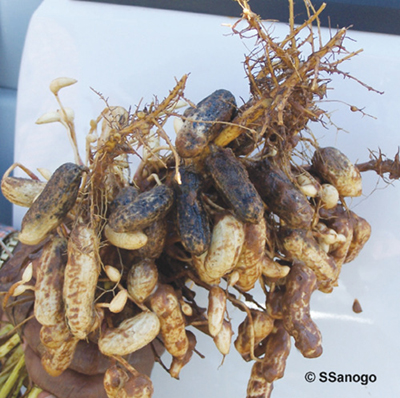
Figure 2. Blackhull (Chalara elegans) of peanut. Note the blackening on infected pods.
In severe cases, the disease may progress from the hull into the kernels. Infected seeds may be covered with black spores of the fungus. Use of such seeds will introduce and spread the blackhull fungus in fields.
Not all hull discoloration is caused by C. elegans. Some non-pathogenic fungi, which live off plant debris, may grow on the surface of the hulls and cause discoloration. This is particularly problematic at harvest time in wet years.
Conditions often associated with blackhull include high pathogen populations in the soil, low temperatures late in the season, heavy-textured and alkaline soils, excessive soil moisture, continuous planting of peanut in the same field, rotation of peanut with cotton, and delayed harvest. Peanuts with high percentages of blackhull are sold at a discount. To reduce the effect of blackhull on peanut quality, several methods may be used to reduce the disease. Plant only clean seeds in wide row spacings, rotate peanuts with small grains to avoid a buildup of the pathogen in the soil, plant in fields with well-drained soil, and avoid excessive irrigation.
Fusarium Diseases
Several species of Fusarium cause various diseases in peanut, including damping-off in seedlings (see Damping-off section) and root rot and wilting in mature plants. Wilting in mature plants is the result of severe root rot and invasion and plugging of the vascular system. Injured roots are predisposed to infection by Fusarium. Prior to wilting, infected plants may display yellowing of leaves and leaf drop. Wilted plants exhibit discoloration in the vascular system in the root and stem. In addition, Fusarium may cause pod diseases consisting of death of very young pods and dry rot in mature pods. Infection by Fusarium may render peanut more susceptible to other pod rot pathogens. Excessive soil moisture predisposes pods to infection by Fusarium and other pod-rotting pathogens.
Once a field has become infected with Fusarium, the infectious spores remain present in the soil for years. Crop rotation practices may help to reduce the speed with which pathogen populations build in the soil, but do little to reduce the number of infectious spores and ultimately do not reduce the incidence or severity of the disease. Consequently, heavily infected fields may not be useful for peanut production in future years. Fungicides are not effective in managing mature plant diseases caused by Fusarium. Management practices that may help reduce mature plant disease include planting in well-drained soils, avoiding injury to the roots, and following good irrigation practices.
Verticillium Wilt
Verticillium wilt is caused primarily by the fungus Verticillium dahliae. This fungus is a long-lived organism that can survive in soil as sclerotia (survival structures) for more than 14 years. In addition, the fungus can attack and survive on many crops and weeds. The presence of northern root-knot nematode in fields infested with V. dahliae may increase the disease.
Unlike Fusarium, Verticillium does not cause root rot in peanut, but like Fusarium, Verticillium invades and plugs vascular tissues in the root and stem and causes wilting in plants. Symptoms of infection by Verticillium include browning of the vascular tissues, yellowing and blackening of leaf edges, leaf curling, stunting, wilting, and premature defoliation.
Disease develops rapidly under drought stress conditions, especially when the air temperature is above 78°F. Under conditions of adequate soil moisture, infected plants may exhibit mild to moderate wilt, but do not die. These plants usually mature earlier than uninfected plants. Therefore, adequate soil moisture should be maintained to alleviate stress on infected plants and allow plants to reach maturity. Managing weeds and nematodes and using a good crop rotation can also help to reduce the disease. Removing or burning infected crop debris can help to reduce inoculum in the soil.
Leaf Diseases
Major leaf diseases commonly found in peanut fields are early and late leaf spot, web blotch, and Botrytis blight. Early and late leaf spot both produce spots on leaves, petioles, stems, and pegs. Early leaf spot, caused by the fungus Cercospora arachidicola, causes tan to brown circular areas with prominent yellow borders. Late leaf spot, caused by Cercosporidium personatum, causes brown to black circular to irregular spots with narrow yellow borders. Web blotch, caused by Phoma arachidicola, causes brown areas on leaves that have distinct webbing or netting patterns (Figure 3). Botrytis blight, caused by Botrytis cinerea (Figure 4), causes irregular tan to brown spots that may cover the entire surface of the leaflet.
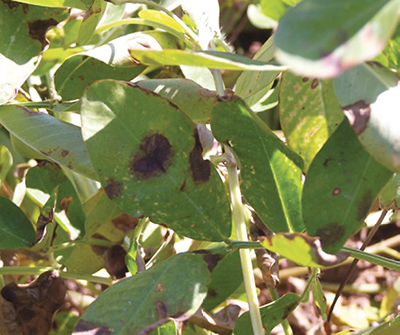
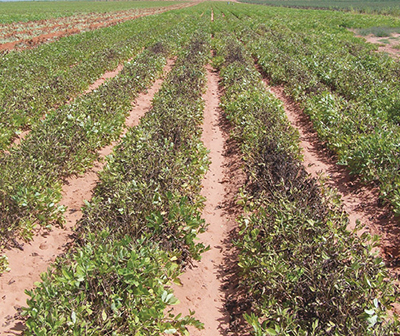
Figure 3. Damage caused to peanut leaves (top) and severe infestation (bottom) of Phoma arachidicola web blotch.
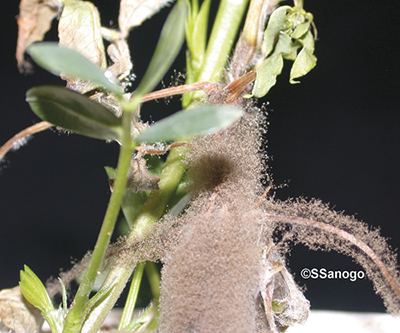
Figure 4. Botrytis blight (Botrytis cinerea) of peanut. The structures with a hairy appearance are due to an abundant production of spores by the fungus.
These diseases are present to some extent in most locations from year to year, but they can reach high levels during wet and humid years. Excessive irrigation and a dense canopy may increase the levels of these diseases by providing a humid environment for germination, growth, and spread of leaf spot fungi.
Leaf spot diseases can be managed by reducing inoculum levels. Following a good crop rotation that allows for fields to be out of peanuts for three years will help to reduce the initial inoculum density in the field. Likewise, plowing under peanut crops and destroying volunteer peanut plants will help to reduce inoculum. When conditions are favorable for disease development, crop rotation and good sanitation practices are insufficient to effectively manage leaf spot diseases. Therefore, applying fungicides when excessive moisture and humidity occur during the growing season is recommended. Fungicides are most effective when used before diseases become established in the field. Fungicides will not eradicate existing infections, but rather work to help reduce the incidence and severity of disease by limiting development and spread of the disease. In order to prevent or delay the development of resistance by the organisms, two or more types of fungicide should be applied. Pre-mixed formulations of fungicides that work together are sold specifically for this purpose. As plants mature, their canopy may prevent lower leaves from being adequately treated, so use application techniques that allow greater penetration of the plant canopy.
Stem Rot (Also Known as Southern Blight or White Mold)
Stem rot is caused by the soil-borne fungus Sclerotium rolfsii. It is usually recognizable by a thin, sinuous, white, web-like fungal structure (mycelium) on the base of plant stems and nearby surrounding soil (Figure 5).
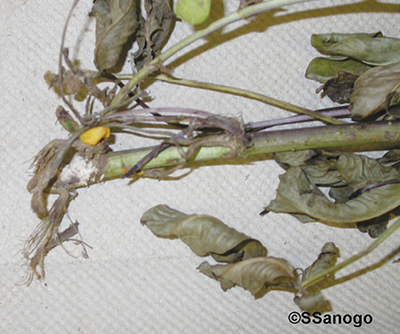
Figure 5. Peanut plant affected by stem rot (Sclerotium rolfsii) with white fungal mycelium at the base of the infected stem.
Small white dots called sclerotia may be found with the mycelium. Sclerotia turn tan to brown with age and serve as overwintering structures for the fungus. Peanut stems, pegs, and pods can all be affected.
Cool, moist weather is required for stem rot, which usually appears during late summer or fall. Plants wilt and die when they are girdled by the fungus, but it is common to find some surviving branches on each affected plant. Typically, the fungus spreads from infected plants to adjacent ones, so visual examination of an infected field may show small patches or areas of wilting or dying plants. Heavy applications of gypsum, sulfur, or fungicides that reach the soil may prevent stem rot from developing on soil surfaces. Under these circumstances, symptomatic plant wilting and death may not occur, and the plants may appear healthy upon visual examination of the field. However, the fungus can still attack developing and mature pods beneath the ground. Producers are advised to occasionally pull plants, especially in low areas of the fields where moisture accumulates, and examine them for below-ground pod infections. Affected pods are tan to light brown, slimy but not wet, often covered with white mycelia, and at maturity are usually completely rotted and not harvestable.
Management strategies for this disease include deep burial of crop residue, flat cultivation to avoid pulling soil and trash toward the plants, crop rotation with grain sorghum to reduce the number of infectious propagules, and use of soil fungicides specific for management of this pathogen. Preventing foliar diseases is also important for managing stem rot. Foliar diseases often cause leaves of the peanut plant to abscise. Dead leaf tissue on the soil surface provides decaying organic matter for the stem rot pathogen to begin growing.
Sclerotinia Blight
Sclerotinia blight, caused by Sclerotinia sclerotiorum, has been recently identified in Curry County. Cool temperatures and prolonged moisture during mid- to late season favor Sclerotinia blight. Plants with Sclerotinia blight display light tan to brown blighted and shredded stems, branches, and leaves (Figure 6).
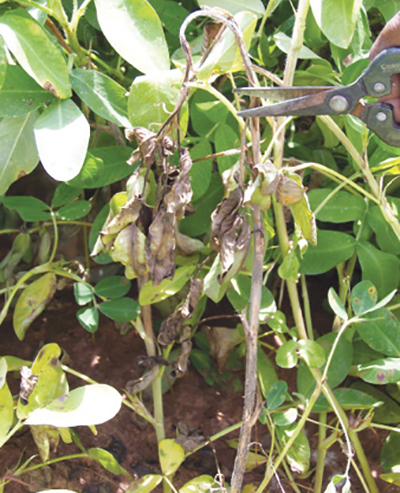
Figure 6. Sclerotinia blight (Sclerotinia sclerotiorum) of peanut. The photo on the top shows the presence of sclerotia (inside red circles) and shredding of infected stem (yellow arrow). Note browning and straw color of infected stem (bottom photo).
White fluffy fungal mycelium is usually found on infected plant parts along with black structures called sclerotia (resembling mouse droppings). Good irrigation management and avoiding excessive water, especially during cool periods, help to reduce the disease.
The extent to which this pathogen has spread in New Mexico is unknown at this time. Every effort should be made to avoid introducing the fungus into fields where the pathogen is not known to occur. Sclerotinia blight is found in most adjacent peanut-growing regions, including parts of Oklahoma and Texas. Therefore, peanut production equipment used outside New Mexico or in fields known to harbor the pathogen should undergo thorough cleaning and washing prior to use. It is highly advised to use only seed grown and produced within the eastern New Mexico growing region.
Pod Rots
Pod rot disease complex is caused by several organisms. The three organisms most commonly associated with pod rot are Pythium species, Rhizoctonia solani, and Sclerotium rolfsii (see Stem Rot section). Depending on the field, one of these organisms may be more prevalent than the others. In most fields surveyed in New Mexico, Rhizoctonia solani was more prevalent than Pythium spp. or S. rolfsii. Pythium species are water molds that cause a wet pod rot, which is a characteristic symptom of infection by this pathogen (Figure 7). When infected pods are squeezed, the inside of the developing pod feels wet and pulpy. If left untreated, these pods will completely rot and will be lost from harvest.
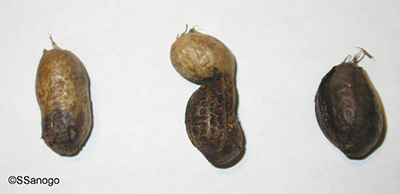
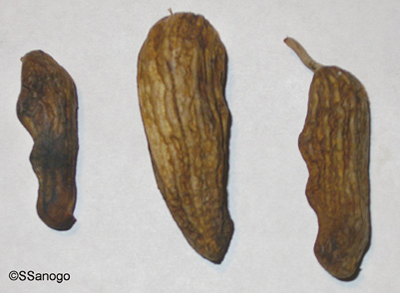
Figure 7. Pythium (top) and Rhizoctonia (bottom) pod rot of peanut. Note the greasy and black appearance of rotted areas on the Pythium-infected pods. Note the ridges on pods infected with Rhizoctonia.
Rhizoctonia, in contrast to Pythium, causes dry, dull, light tan to dark brown indentations on the pod (Figure 7). Pods are predisposed to infection after damage by wireworms. Once the pod has been penetrated, Rhizoctonia gains entrance to the kernels inside and begins to destroy them. Empty, rotted, lightweight pods often blow out during harvest, while partially destroyed kernels increase concealed damage at grading.
Pod rots may not exhibit noticeable above-ground symptoms. Therefore, occasionally pulling plants throughout the field, especially during pod maturation, is important because it is the only way pod rots can be detected. Healthy vines do not automatically indicate healthy pods and peanuts below the soil. Fungicide applications can help reduce the incidence and severity of pod rots if applied early in the development of disease. Identifying the causal agent (Table 5) is important because different organisms are managed by different fungicides. Proper fungicide treatment, if required, must begin early enough so as to not exceed label application restrictions regarding the number of days before harvest.
|
Table 5. Guide for Distinguishing Pod Rots |
|||
|
Item |
Pythium spp. |
Rhizoctonia spp. |
Sclerotium spp. |
|
Pod color |
Dark brown to black |
Light tan to dark brown |
Tan to light brown |
|
Moisture level of affected pods |
Water when squeezed |
Dry |
Moist and slimy but not watery |
|
Most favorable soil moisture levels |
Too wet |
Normal |
Normal to dry |
Tomato Spotted Wilt Virus
Tomato spotted wilt virus (TSWV) can cause serious economic losses in some peanut-growing regions in the United States. The virus has been found in peanuts grown in New Mexico, although significant yield losses have not been reported. The virus has an extremely wide host range and infects many crop plants and weeds. In the field, the virus is transmitted by thrips. Only immature thrips are able to acquire the virus when feeding on infected plants, but the virus is retained and multiplies in the insect so that both larvae and mature thrips can pass the virus to uninfected plants.
Symptoms caused by TSWV are highly variable. Infected plants may exhibit chlorotic spots, mild mosaic or mottling, necrotic and chlorotic rings and streaks, chlorotic line patterns, leaf distortion, puckering, and stunting. When young seedlings are infected, the plant may die. Plants infected early in the season are usually stunted and have a bushy appearance due to the proliferation of axillary shoots. When mature plants are infected, plants may also be stunted, but only a few branches or just the branch tips may be affected. Plants infected early in the season produce small, shriveled seed with red, brown, or purple mottling on the seed coat. Plants infected later in the season may produce seed of normal size, but the seed coat is often discolored or cracked.
Cultural practices that result in the establishment of a good stand with optimal plant population and spacing and provide good growing conditions that allow for rapid closure of the plant canopy can help reduce the number of plants infected with TSWV. Large gaps in plant spacing or slow growth may lead to an increase in plants infected with the virus since these conditions are more attractive to the insect vector. Management of the insect vector has not proven to be effective in reducing the disease.
Nematodes
Plant-parasitic nematodes are microscopic worms that live in the soil and infect plants. Two types, root-knot and root-lesion nematodes, are known to cause problems in New Mexico. Two different root-knot nematodes occur in the state’s peanut-producing areas, but only one—the northern root-knot nematode—commonly causes damage. On rare occasions, high numbers of southern root-knot nematodes left over from the previous year’s chile or grain crops have caused seedling death. Typically, only small areas of fields are affected, but widespread infestations can destroy a crop, particularly when northern root-knot nematodes are present.
Northern root-knot nematodes cause galls to form on peanut roots, pegs, and pods (Figure 8). Plants that are severely affected by root-knot nematodes are stunted and may be lighter green or yellowish in color. During field inspection, healthy, normal-sized plants provide a marked contrast to stunted ones affected by nematodes. Small patches within a field are generally involved, and plants of different heights can occur within affected areas. If infested areas are not treated, over time the organisms can be spread throughout the field during normal yearly field preparation and cultivation. Unlike southern root-knot nematodes, northern root-knot nematodes can be reduced by rotating small grains or forages before peanut crops. Growing susceptible crops like chile or bean before peanut is likely to increase damage from northern root-knot nematodes.
Root-lesion nematodes affect roots, pegs, and pods and can cause small spots on pods (Figure 8). These spots are tan with a dark center. Root-lesion nematodes have a wide range of host plants, including most grains, and therefore cannot be managed by crop rotation where nematode populations are high. Nematicides can be used to control both root-lesion and root-knot nematodes. Soil samples are the best way to determine if plant-parasitic nematodes are damaging peanut. Because nematodes cannot be eliminated, knowing if they are present and which types are present allows better management decisions in the future. With new nematicide chemistry currently available, at-plant as well as pre-plant control options are now obtainable to growers.
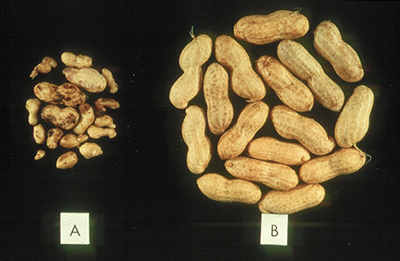

Figure 8. Damage caused to peanuts from root-knot, Meloidogyne hapla (top photo, A), and root-lesion, Pratylenchus brachyurus (bottom photo), nematodes.
Insects
Insects are usually not a major problem for peanut producers in eastern New Mexico. Control of thrips in peanuts is believed to assist the early development of plants, but research has demonstrated little economic improvement from their management. The main concern associated with thrips is the spread of TSWV. Armyworms are an occasional problem in some areas. The moths, which are active at night, are dark gray with a noticeable whitish spot near the extreme tip of the wings. The larvae feed day and night. Larvae color ranges from dark tan to green to nearly black, and they have three yellowish-white lines down their back. Some peanut fields adjacent to grassland are occasionally damaged by grasshoppers. Both armyworms and grasshoppers are easily controlled by labeled insecticides.
Additional Peanut Production Resources
For more information on peanut production in Texas and on different types of peanuts (e.g., Virginia and runner) grown in the region, see the Texas Peanut Production Guide, available at https://peanut.tamu.edu.
National Peanut Research Laboratory: https://www.ars.usda.gov/southeast-area/dawson-ga/national-peanut-research-laboratory/
National Peanut Board: https://www.nationalpeanutboard.org
Peanut Disease Atlas (PDF): https://agrilifecdn.tamu.edu/peanut/files/2012/04/Peanut-Disease-Atlas_1.pdf
New Mexico Peanut Growers Association; New Mexico Peanut Research Board: Contact Wayne Baker, President, 575-356-8996
For Further Reading
CR-676: Interpreting Soil Tests: Unlock the Secrets of Your Soil
https://pubs.nmsu.edu/_circulars/CR676/
H-158: How to Collect and Send Specimens for Disease Diagnosis
https://pubs.nmsu.edu/_h/H158/
H-616: Herbicide Resistance: Development and Management
https://pubs.nmsu.edu/_a/A616/
References
Baughman, T. (Ed.). 2007. Texas peanut production guide [Texas AgriLife Extension Pub. B-1514]. College Station: Texas A&M University.
Kokalis-Burelle, N., D.M. Porter, R. Rodriquez-Kabana, D.H. Smith, and P. Subrahmanyam (Eds.). 1997. Compendium of peanut diseases, 2nd ed. St. Paul, MN: The American Phytopathological Society.
McFarland, M., R. Lemon, and C. Stichler. 2002. Irrigation water quality: Critical salt levels for peanuts, cotton, corn, and grain sorghum [Texas AgriLife Extension Pub. L-5417]. College Station: Texas A&M University.
Trostle, C. 2004. Peanut production ‘keys & concerns’—Texas south plains. Lubbock: Texas A&M University, Texas AgriLife Extension.
Trostle, C. 2005. Rhizobium nodulation and peanut. FOCUS on Entomology, vol. XLIV, no. 2. Lubbock: Texas A&M University, Texas AgriLife Extension.
Original authors: Mark A. Marsalis, Extension Agronomist, Agricultural Science Center at Clovis; Naveen Puppala, Peanut Breeder, Agricultural Science Center at Clovis; Natalie P. Goldberg, Extension Plant Pathologist, Department of Extension Plant Sciences; Jamshid Ashigh, Extension Weed Specialist, Department of Extension Plant Sciences; Soumaila Sanogo, Plant Pathologist, Department of Entomology, Plant Pathology and Weed Science, all of New Mexico State University. Calvin Trostle, Extension Agronomist, Texas AgriLife Extension, Lubbock, TX.

Naveen Puppala is a peanut breeder at NMSU’s Agricultural Science Center at Clovis. His current research uses molecular techniques and conventional breeding approaches to develop Valencia peanut varieties with high yields, four-seeded pods, good taste, and disease resistance.
Brand names appearing in publications are for product identification purposes only. No endorsement is intended, nor is criticism implied of similar products not mentioned. Persons using such products assume responsibility for their use in accordance with current label directions of the manufacturer.
To find more resources for your business, home, or family, visit the College of Agricultural, Consumer and Environmental Sciences on the World Wide Web at pubs.nmsu.edu
Contents of publications may be freely reproduced for educational purposes. All other rights reserved. For permission to use publications for other purposes, contact pubs@nmsu.edu or the authors listed on the publication.
New Mexico State University is an equal opportunity/affirmative action employer and educator. NMSU and the U.S. Department of Agriculture cooperating.
Revised December 2018 Las Cruces, NM

